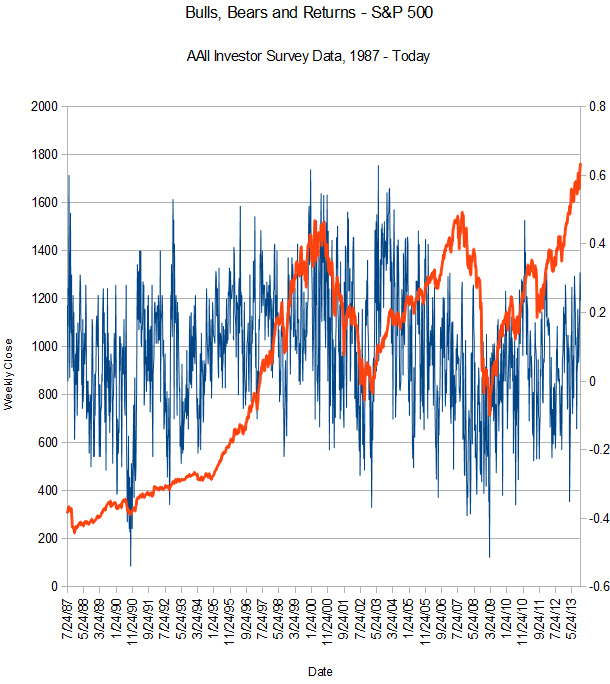We've gone from Ivory Tower to Wall Street and back to Ivory Tower in this discussion about trying to divine the proper valuation for the stock market. However, the vast majority of investors (if not an outright majority of wealth) come in a far more down to earth form - the individual investor, or , if you prefer, Main Street.
This article is a bit different from the first three - and you'll definitely enjoy the 'why'.
See The Finale - What Does it Mean?
Herd Behavior and Irrationality
Chew on this - a strong efficient market hypothesis doesn't just tell us that it's useless to try to 'beat' the market because risk is priced rationally. It also tells us something much stranger - that even if you do attempt to outsmart the market indices, you shouldn't 'lose' the the market by more than transaction costs and perhaps the mis-pricing of risk. Would that were the case!
On the left you can see probably the most famous magazine cover ever to grace the PowerPoint slides of various Wall Street firms. For the younger readers and the otherwise uninitiated, that cover ran back in August of 1979 - during the so-called "malaise" phase of President Jimmy Carter's Presidency.
And yes, it wasn't just a President Carter thing. A quick glance at the S&P 500 during those days shows that investor money wasn't really doing anything - the stock market was like a black hole, swallowing whatever investments people chose to make. The cover, then, was actually a reflection of popular opinion - investor sentiment had soured to an incredibly low point, and the cover just reflected the mood of the common (wo)man.
Malaise, flat returns, a lame-duck first term Presidency and scary magazine covers - horrible time to invest, right? Well, let's check the best S&P 500 Total Return Calculator on the web!
August 1979 - October 2013 (retrieved 11/5/2013): 11.385% annually, 7.680% above inflation
Hope you didn't listen to the cover!
As stated in the research paper above, there are a lot of reasons individual investors under-perform:
- Poor tax strategy - selling winners too early, holding onto losers too long
- Poor risk pricing - buying high and selling low; improper allocation
- Poor information filtering - buy the news, pay too much attention to past returns
- Poor psychological profile - "repeating past behaviors that coincided with pleasure while avoiding past behaviors that generated pain"
- Lack of diversification - too few holdings. (Although this one is a wild card)
Trust the Contrarian Impulses
"You know it's time to sell when shoeshine boys give you stock tips. This bull market is over." - Joeseph Kennedy
"A bull market hasn't peaked until the last bear turns bullish." - Trader's proverb
This is the point where I tell you that the easiest way to manage your failings is to invest in an index fund, or, perhaps, in a target date fund. Of course, this article must go on: let's look at investor sentiment. Remember - overly pessimistic or overly optimistic sentiment means we should either be excited or wary, respectively.
Investor Sentiment at a Glance
The keeper of investor sentiment data is the American Association of Individual Investors. Since 1987, they have been surveying their members weekly for their thoughts on market performance over the next six months. Armed with this valuable data and large sample, AAII even published some work stating that sentiment was a great contrarian indication - noting that pessimism peaked in March of 2009, right in time for the last leg up.
 Orange - S&P 500 Index Weekly Closing Prices
Orange - S&P 500 Index Weekly Closing Prices
Blue - Bullish sentiment minus bearish sentiment (positive means overall bullish, negative means overall bearish)
Okay, that chart could probably use some revisions to better smooth the data, but here are the stats (remember, our made up indicator is 'bullish minus bearish'):
| Average | 8.29% |
| Median | 8.89% |
| Maximum | 62.86% |
| Max Date | 01/06/00 |
| Minimum | -54.00% |
| Min Date | 10/19/90 |
The reading on 11/6 was 23.7%.
So, It's Overpriced?
Well, you see the chart... it could definitely use some smoothing or seasonal adjustments. But, yes, sentiment is running a bit higher than the norm, so you could say people are being a bit overly greedy. Remember, (almost by definition) the best time to buy is when others are fearful - their improving mood means you'll have people moving into your investment after you.
The worst time to buy? When everyone is already raving about an investment Where is the additional money going to come from? It's already there - there are only so many 'greater fools'. And here's something funny about fools - they are soon separated from their money.
So, once again in our series, another indicator is becoming a bit overheated. Just keep it in mind while you allocate your assets - and good luck out there!


